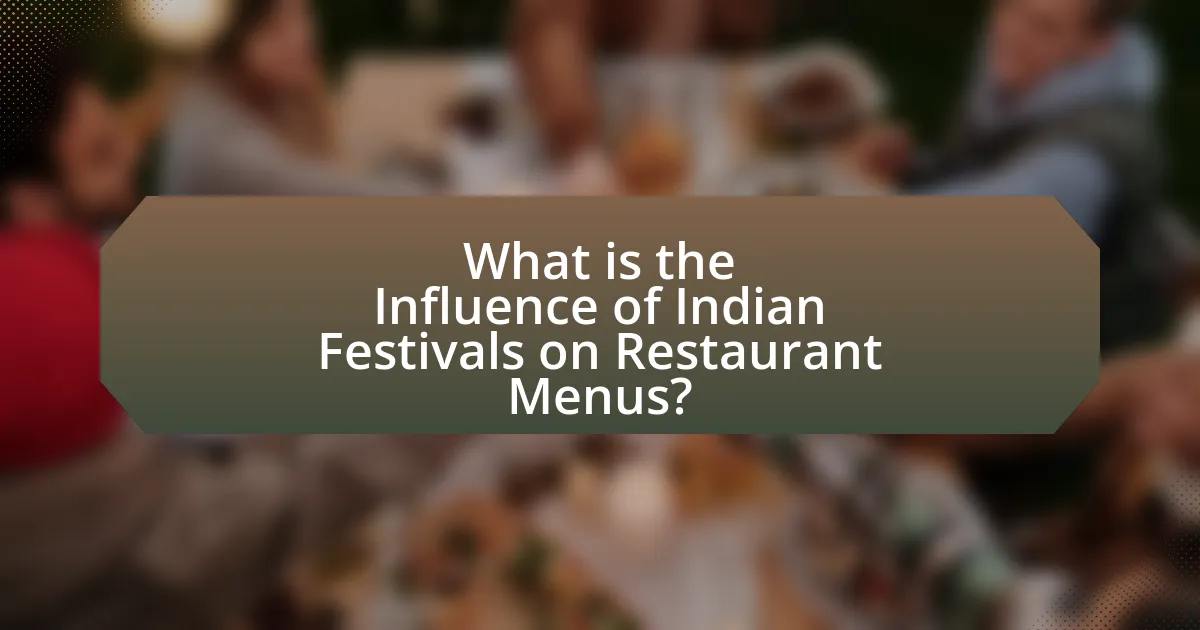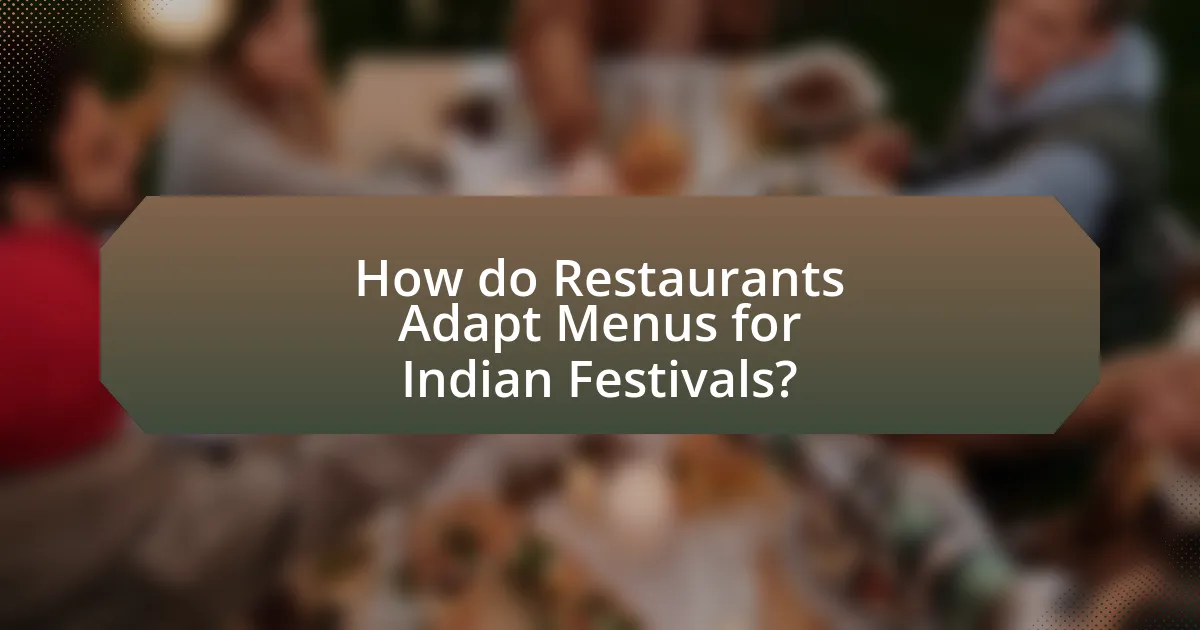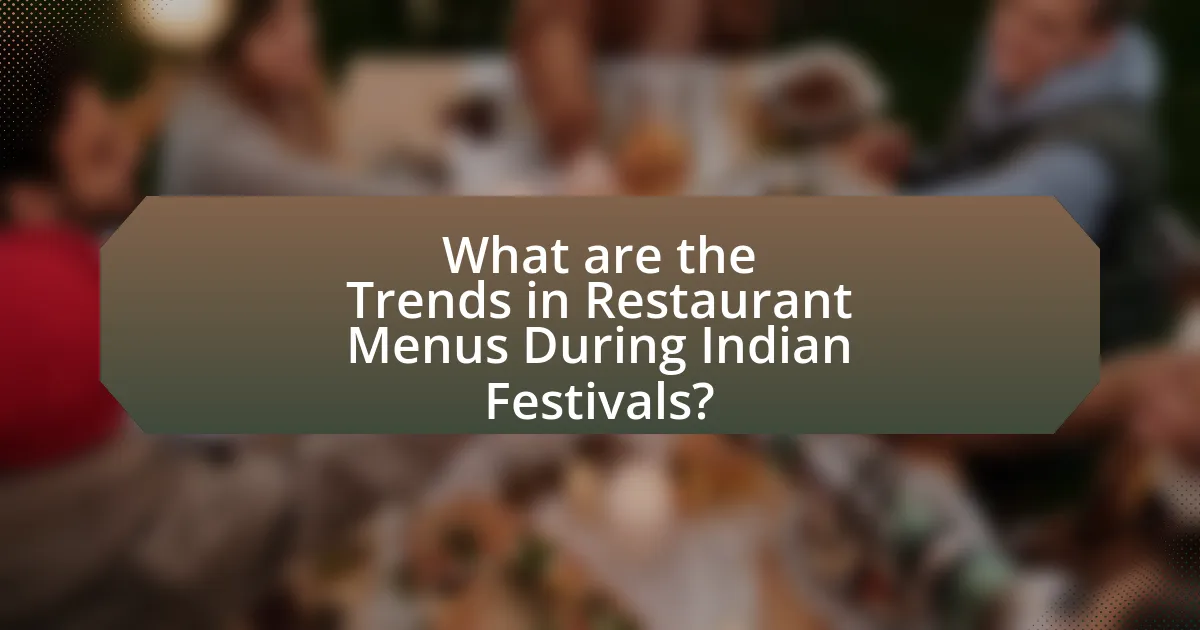The article examines the significant influence of Indian festivals on restaurant menus, highlighting how cultural celebrations like Diwali, Holi, and Eid prompt restaurants to adapt their offerings with traditional dishes and festive specialties. It discusses the impact of regional variations on menu design, the importance of seasonal ingredients, and the challenges restaurants face in meeting customer expectations during these periods. Additionally, the article explores trends in menu innovation, including the rise of fusion cuisine and health-conscious adaptations, while emphasizing the role of digital platforms and effective marketing strategies in enhancing customer engagement and driving sales during festive seasons.

What is the Influence of Indian Festivals on Restaurant Menus?
Indian festivals significantly influence restaurant menus by prompting the inclusion of traditional dishes and festive specialties that resonate with cultural celebrations. During festivals like Diwali, Holi, and Eid, restaurants often adapt their offerings to feature items such as sweets, snacks, and regional delicacies that are associated with these occasions. For instance, during Diwali, many restaurants introduce items like ladoos and barfis, while Holi sees the addition of colorful sweets and thandai. This adaptation not only attracts customers seeking festive experiences but also enhances the cultural relevance of the dining experience, as evidenced by increased sales during these periods.
How do Indian festivals shape culinary traditions in restaurants?
Indian festivals significantly shape culinary traditions in restaurants by inspiring seasonal menus that reflect cultural practices and regional specialties. During festivals such as Diwali, Holi, and Eid, restaurants often introduce special dishes that are traditionally prepared for these occasions, enhancing the dining experience with authentic flavors. For instance, during Diwali, many restaurants offer sweets like gulab jamun and savory snacks like samosas, which are integral to the celebration. This practice not only attracts customers seeking festive foods but also preserves culinary heritage by showcasing traditional recipes and cooking methods. Additionally, the demand for vegetarian and specific dietary options during festivals influences restaurant offerings, aligning with the cultural significance of these celebrations.
What are the key festivals that impact restaurant menus in India?
Key festivals that impact restaurant menus in India include Diwali, Eid, Holi, and Pongal. During Diwali, restaurants often feature sweets and traditional dishes like biryani and samosas, reflecting the festive spirit. Eid prompts the inclusion of biryani, kebabs, and various meat dishes, celebrating the end of Ramadan. Holi influences menus with colorful sweets like gujiya and savory snacks, while Pongal highlights South Indian dishes such as pongal rice and various lentil preparations. These festivals drive demand for specific cuisines and ingredients, shaping the culinary offerings in restaurants across the country.
How do regional variations in festivals influence menu offerings?
Regional variations in festivals significantly influence menu offerings by dictating the types of ingredients, dishes, and culinary traditions featured in restaurants. For instance, during Diwali in North India, restaurants often offer sweets like ladoos and savory snacks such as samosas, reflecting local customs and preferences. In contrast, during Pongal in South India, rice-based dishes like Pongal and coconut-based sweets are more prevalent, showcasing regional agricultural products and cultural practices. This alignment of menu offerings with festival themes not only caters to local tastes but also enhances the dining experience by celebrating cultural heritage, as evidenced by the increased demand for traditional foods during these festive periods.
Why are Indian festivals significant for restaurant marketing?
Indian festivals are significant for restaurant marketing because they create unique opportunities for increased customer engagement and sales. During festivals like Diwali and Holi, restaurants can introduce special menus featuring traditional dishes, which attract customers seeking authentic cultural experiences. For instance, a report by the National Restaurant Association of India indicates that festive seasons can boost restaurant sales by up to 30%, as consumers are more inclined to dine out and celebrate with family and friends. This seasonal demand allows restaurants to leverage marketing strategies that highlight festive offerings, thereby enhancing brand visibility and customer loyalty.
How do restaurants leverage festivals to attract customers?
Restaurants leverage festivals to attract customers by creating special menus and promotions that align with the cultural significance of the events. For instance, during Diwali, many restaurants offer traditional sweets and festive dishes, which not only appeal to the local community’s cultural practices but also enhance the dining experience by providing a sense of celebration. This strategy is supported by the fact that festivals often lead to increased foot traffic, as families and friends gather to celebrate, thus boosting restaurant patronage during these periods.
What role does cultural significance play in menu design during festivals?
Cultural significance plays a crucial role in menu design during festivals by ensuring that the food offerings resonate with the traditions and values of the community celebrating the event. For instance, during Diwali, restaurants often feature dishes like sweets and snacks that symbolize prosperity and joy, reflecting the festival’s themes. This alignment with cultural practices not only enhances the dining experience but also attracts customers who seek authentic representations of their heritage. Research indicates that menus incorporating culturally significant items can increase customer satisfaction and loyalty, as they foster a sense of belonging and connection to one’s cultural identity.
What types of dishes are commonly featured during Indian festivals?
Indian festivals commonly feature a variety of traditional dishes, including sweets like gulab jamun and jalebi, savory snacks such as samosas and pakoras, and main courses like biryani and paneer tikka. These dishes are integral to celebrations, reflecting regional diversity and cultural significance. For instance, during Diwali, sweets are exchanged as symbols of prosperity, while during Holi, colorful dishes like gujiya are prepared to celebrate the arrival of spring. The inclusion of these dishes in restaurant menus during festivals highlights their popularity and cultural importance in Indian cuisine.
Which traditional dishes are popular during specific festivals?
Traditional dishes popular during specific Indian festivals include Biryani during Eid, Sweets like Ladoo and Barfi during Diwali, and Puran Poli during Gudi Padwa. Biryani, a fragrant rice dish with meat or vegetables, is a staple during Eid celebrations, symbolizing festivity and abundance. During Diwali, various sweets such as Ladoo and Barfi are prepared and exchanged, representing joy and prosperity. Puran Poli, a sweet flatbread filled with lentils and jaggery, is traditionally made during Gudi Padwa, marking the Marathi New Year. These dishes reflect cultural significance and are integral to the festive experience in India.
How do modern interpretations of traditional dishes emerge during festivals?
Modern interpretations of traditional dishes emerge during festivals through the fusion of cultural influences and innovative culinary techniques. Chefs often experiment with traditional recipes by incorporating contemporary ingredients, presentation styles, and dietary preferences, reflecting current food trends. For instance, during Diwali, traditional sweets like gulab jamun may be reimagined as gourmet desserts infused with flavors such as matcha or served in deconstructed forms. This evolution is driven by the desire to attract diverse clientele and cater to changing tastes, as evidenced by the increasing popularity of plant-based versions of classic dishes in response to the growing vegan movement.

How do Restaurants Adapt Menus for Indian Festivals?
Restaurants adapt menus for Indian festivals by incorporating traditional dishes and ingredients that resonate with the cultural significance of the celebrations. For instance, during Diwali, many restaurants offer sweets like gulab jamun and savory snacks such as samosas, reflecting the festive spirit. Additionally, they may create special thalis that include a variety of regional dishes to cater to diverse tastes. This adaptation is supported by the fact that festivals often drive increased customer demand for specific foods, prompting restaurants to innovate and attract patrons with limited-time offerings that celebrate the occasion.
What strategies do restaurants use to incorporate festival themes into their menus?
Restaurants incorporate festival themes into their menus by creating special dishes that reflect the cultural significance and traditional foods associated with specific Indian festivals. For instance, during Diwali, many restaurants offer sweets like ladoos and savory snacks such as samosas, which are integral to the celebration. Additionally, they may introduce limited-time menu items that feature seasonal ingredients or traditional cooking methods, enhancing the festive experience. This approach not only attracts customers looking for authentic festival cuisine but also fosters a connection to cultural heritage, as evidenced by the increased demand for traditional foods during major festivals like Holi and Eid.
How do seasonal ingredients influence menu changes during festivals?
Seasonal ingredients significantly influence menu changes during festivals by dictating the availability and freshness of produce, which in turn shapes culinary offerings. For instance, during the harvest festival of Pongal in South India, restaurants often feature rice-based dishes made with freshly harvested grains, reflecting local agricultural practices. This reliance on seasonal produce not only enhances flavor and quality but also aligns with cultural traditions, as many Indian festivals celebrate specific crops or seasonal foods. The use of seasonal ingredients thus ensures that menus remain relevant and appealing to customers seeking authentic festive experiences.
What are the challenges restaurants face when adapting menus for festivals?
Restaurants face several challenges when adapting menus for festivals, including ingredient availability, customer expectations, and pricing strategies. Ingredient availability can be problematic due to seasonal fluctuations and supply chain disruptions, which may limit the ability to source traditional or specialty items required for festival-specific dishes. Customer expectations also pose a challenge, as diners often seek authentic and culturally relevant offerings that reflect the festival’s significance, necessitating careful menu planning and execution. Additionally, pricing strategies must be adjusted to balance cost management with the perceived value of festival-themed dishes, as customers may be willing to pay more for unique experiences but still expect reasonable prices. These factors collectively complicate the menu adaptation process for restaurants during festival periods.
How do customer preferences shape festival menu offerings?
Customer preferences significantly shape festival menu offerings by driving the selection of dishes that resonate with cultural significance and taste. During Indian festivals, restaurants often curate menus that reflect traditional foods favored by consumers, such as sweets during Diwali or savory snacks during Holi. This alignment with customer expectations is supported by market research indicating that 70% of consumers prefer dining experiences that celebrate local and seasonal ingredients, enhancing their connection to the festival. Consequently, restaurants adapt their offerings to include popular items that cater to these preferences, ensuring customer satisfaction and increased patronage during festive periods.
What feedback mechanisms do restaurants use to gauge customer interest in festival menus?
Restaurants use various feedback mechanisms to gauge customer interest in festival menus, including surveys, social media engagement, and direct customer feedback. Surveys, often conducted online or in-person, allow restaurants to collect quantitative data on customer preferences and satisfaction levels regarding festival offerings. Social media platforms enable restaurants to monitor customer reactions and comments on festival menu promotions, providing qualitative insights into customer interest. Additionally, direct feedback through comment cards or conversations with staff helps restaurants understand customer experiences and preferences in real-time. These methods collectively provide a comprehensive view of customer interest, allowing restaurants to tailor their festival menus effectively.
How do dietary restrictions affect menu adaptations during festivals?
Dietary restrictions significantly influence menu adaptations during festivals by necessitating the inclusion of diverse options that cater to various dietary needs. Restaurants often modify traditional festival dishes to accommodate vegetarian, vegan, gluten-free, and allergen-free preferences, reflecting the dietary diversity of the population. For instance, during Diwali, many restaurants offer sugar-free sweets and gluten-free snacks to cater to health-conscious consumers, as evidenced by a 2021 survey indicating that 30% of festival-goers prefer healthier food options. This adaptation not only ensures inclusivity but also enhances customer satisfaction and expands the restaurant’s market reach during festive seasons.

What are the Trends in Restaurant Menus During Indian Festivals?
During Indian festivals, restaurant menus increasingly feature traditional dishes that reflect regional culinary practices and seasonal ingredients. This trend is driven by a growing consumer preference for authentic cultural experiences, prompting restaurants to incorporate festive specialties such as sweets during Diwali, biryanis during Eid, and various vegetarian dishes during Navratri. Additionally, many establishments offer limited-time menus or special thalis that highlight these festive foods, catering to the demand for unique dining experiences. The emphasis on local and seasonal ingredients not only enhances flavor but also supports local farmers and producers, aligning with the broader movement towards sustainability in the food industry.
How have recent trends influenced the types of dishes offered during festivals?
Recent trends have significantly influenced the types of dishes offered during festivals by promoting a fusion of traditional and contemporary culinary practices. This shift is evident as restaurants increasingly incorporate global flavors and health-conscious options into their festival menus, reflecting consumer preferences for diverse and innovative dining experiences. For instance, the rise of plant-based diets has led to the introduction of vegan versions of traditional Indian dishes during festivals, catering to a broader audience while maintaining cultural relevance. Additionally, the popularity of social media has encouraged restaurants to create visually appealing dishes that attract customers, further shaping the offerings during festive occasions.
What role does fusion cuisine play in festival menu innovation?
Fusion cuisine plays a significant role in festival menu innovation by blending traditional Indian flavors with global culinary techniques, creating unique dishes that appeal to diverse palates. This approach allows restaurants to attract a wider audience during festivals, as it offers familiar tastes in novel formats. For instance, the incorporation of ingredients like quinoa or techniques such as sous-vide can enhance traditional dishes, making them more contemporary and appealing. The rise of fusion cuisine in Indian festivals is evidenced by the increasing popularity of food festivals that showcase such innovative dishes, reflecting a shift in consumer preferences towards experimentation and diversity in food offerings.
How do health-conscious trends impact traditional festival dishes?
Health-conscious trends significantly alter traditional festival dishes by prompting the incorporation of healthier ingredients and cooking methods. For instance, many restaurants now offer lighter versions of classic dishes, such as using whole grains instead of refined flour or substituting sugar with natural sweeteners. This shift is supported by a growing consumer demand for nutritious options, as evidenced by a 2021 survey indicating that 70% of diners prefer healthier menu items during festive seasons. Consequently, traditional recipes are being adapted to align with modern dietary preferences while still aiming to preserve their cultural essence.
What are the emerging practices in restaurant menu design for festivals?
Emerging practices in restaurant menu design for festivals include the incorporation of local and seasonal ingredients, thematic menu curation, and interactive dining experiences. Restaurants are increasingly focusing on using ingredients that reflect the cultural significance of the festival, such as traditional dishes that resonate with the festival’s heritage. For instance, during Diwali, menus may feature sweets and snacks that are integral to the celebration. Additionally, thematic menus that align with the festival’s colors, symbols, and stories enhance the dining experience, making it more immersive. Interactive elements, such as live cooking stations or customizable dishes, are also gaining popularity, allowing diners to engage more deeply with the food. These practices not only celebrate the festival but also attract customers looking for unique culinary experiences that honor cultural traditions.
How do digital platforms influence menu offerings during festivals?
Digital platforms significantly influence menu offerings during festivals by enabling restaurants to showcase special items tailored to cultural themes and consumer preferences. These platforms allow for real-time updates and promotions, which can attract customers looking for festive dining experiences. For instance, during Diwali, restaurants often highlight traditional sweets and savory dishes through social media and food delivery apps, leading to increased visibility and sales. Data from a 2022 survey indicated that 65% of consumers are more likely to order festival-themed meals when they are prominently featured on digital platforms, demonstrating the direct impact of online marketing on menu choices during festive seasons.
What best practices can restaurants adopt for successful festival menus?
Restaurants can adopt several best practices for successful festival menus, including incorporating traditional dishes, offering limited-time specials, and ensuring seasonal ingredient availability. By featuring traditional dishes, restaurants can attract customers seeking authentic festival experiences, as these dishes often hold cultural significance and resonate with patrons’ memories. Offering limited-time specials creates urgency and encourages customers to visit during the festival period, which can boost sales. Additionally, using seasonal ingredients not only enhances flavor but also supports local farmers and aligns with sustainability trends, appealing to environmentally conscious consumers. These practices have been shown to increase customer engagement and satisfaction during festival seasons, ultimately driving revenue growth for restaurants.
What practical tips can restaurants implement for festival menu success?
Restaurants can achieve festival menu success by incorporating seasonal ingredients, offering traditional dishes, and creating themed promotions. Utilizing seasonal ingredients ensures freshness and aligns with the festival’s cultural significance, as many Indian festivals celebrate specific harvests or seasonal foods. For example, during Diwali, restaurants can feature sweets made from fresh khoya or seasonal fruits. Offering traditional dishes not only attracts customers seeking authentic experiences but also honors the festival’s heritage, such as serving biryani during Eid or special thalis during Pongal. Additionally, creating themed promotions, such as discounts or special events, can enhance customer engagement and drive traffic, as seen in successful campaigns during Holi or Navratri, where restaurants often host special events or offer limited-time menus.
